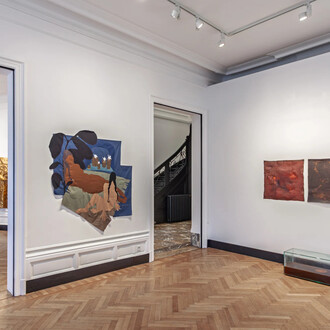This exhibition shows one monumental work by Carl Andre: Thebes. Made out of Western red cedar wood in 2003, the work measures 120 x 90 x 1080 cm and exists out of 48 timbers, one row of 12 vertical timbers mounting one traverse horizontal tee timber each, flanked at base by two parallel rows of 12 horizontal timbers all based on the floor. The artist uses the pieces of wood in the form of modules with standardised dimensions. As with all his sculptures the elements are connected to the ground in three ways: stacked, spread flat either on a grid or contiguously. By ways of stacking the work demands a physical involvement of the viewer, walking past the work gives you a sense of its mass, length, volume and even the smell of the cedar wood.Carl Andre was one of the founders of the art movement known as Minimal Art.
It is an art that seeks to eliminate everything decorative, extraneous and additive, reducing all components to art’s purest elements. The movement included artists from his generation such as Donald Judd, Sol LeWitt, Dan Flavin, Eva Hesse and Robert Morris. Carl distanced sculpture from processes of carving, modelling or constructing to simply involve sorting and placing. The artist has described his works as ‘something between a piece of architectural sculpture and a carpet’.He began making his first wooden sculptures in the late fifties, inspired by Constantin Brancusi. The work "Endless Column" by Brancusi made a particular impression on Carl Andre. He saw the work pushing through the boundaries of sculpture and the infinite without losing the union with earth through the vertical repetition of identical modules. These are elements we can recognize in the exhibited work Thebes, the horizontal repetition of the modules, connected closely to the scale and proportions of its immediate surrounding.
Enrico Castellani (1930, Castelmassa) is regarded one of Italy’s most important living artists. He studied art and architecture in Belgium, at the Académie Royale des Beaux-Arts and École Nationale Supérieure des Beaux-Arts. He started challenging the confines of painting, sculpture and architecture in the early 1950s in search of a new paradigm. He dedicated himself to the space of the canvas in a multidimensional way. By use of an unconventional and ingenious technique he stretches the canvas like a membrane on an underlying nail structure. These are called "Superficies" pieces, on a monochrome canvas, mostly white. To make them he uses a nail gun to produce a relief-like surface that induces light and shade effects through alternating depressions and raised areas. They reveal a geometrical pattern, a rhythm of positive and negative space, of light and shadow. The idea behind this was to radically redefine the notion of painting. Together with Piero Manzoni he was a catalytic figure in the post-war avant garde in Europe and Italy. They started the Azimut gallery together, organised international exhibitions and published essays that opposed dominant art movements at the time. The central idea was to arrive at an art that offered a fresh view on techniques and materials in stead of imitate an existing form. With this ambition in mind he showed his “Suferficie nera” pieces for the first time in 1959 and has been working with this technique throughout his career. The installation on the first floor of the gallery of work by both artists is remi-niscent of architectural and spatial installations, they invite the viewer to walk through the (pictorial) space.
















